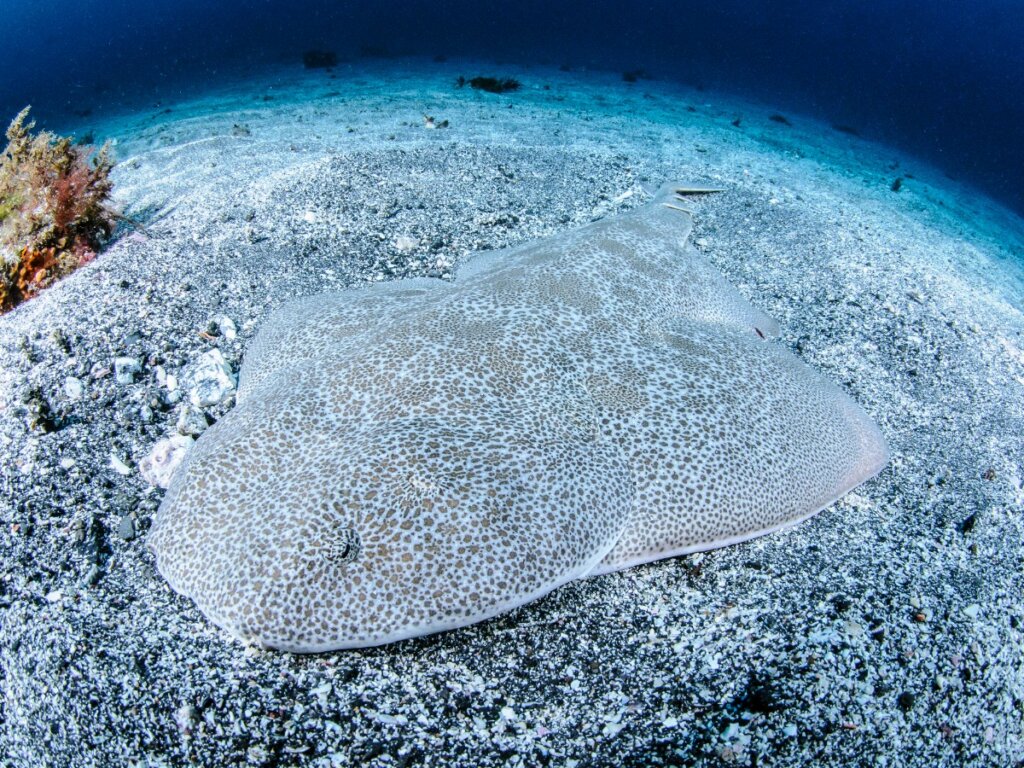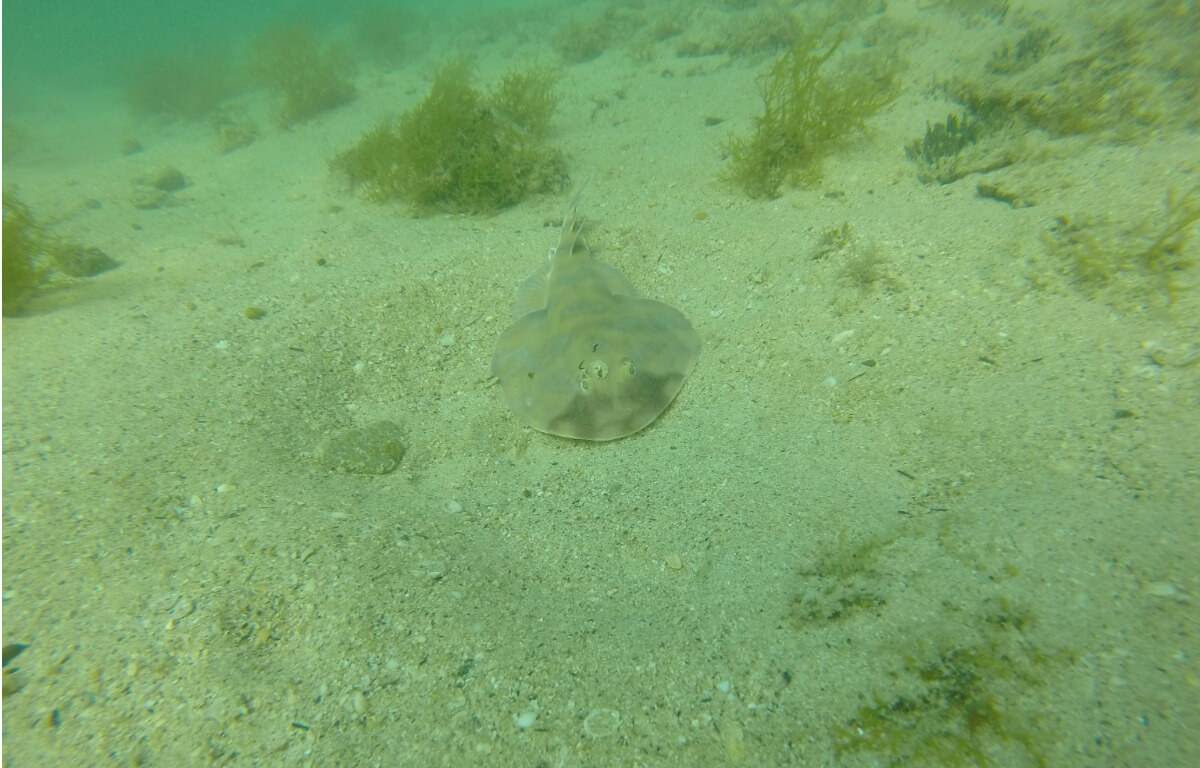Angel Shark: Habitat and Characteristics

Not all marine animals that populate the night are the stuff of nightmares. The angel shark is a good example of this. Curiously similar to rays, its sinuous and flattened appearance has left its mark on researchers and divers alike.
Its small size and distinct appearance from other sharks have made it go unnoticed among its congeners in terms of conservation issues. However, it’s in critical danger of extinction. Get to know all its characteristics before it’s too late.
Angel shark habitat
First of all, it’s necessary to emphasize that this species (Squatina oculata) belongs to the Squatina genus, included in the Squatinidae family. A total of 24 species are recognized in this genus of chondrichthyan fish, all of them inhabitants of shallow sandy bottoms – about 150 meters (500 feet).
For its part, the angel shark lives mainly in the waters of the western Mediterranean and the Greek coasts. It can also be found in the coastal areas of Morocco, Angola, and the Black Sea, as well as parts of the Atlantic Ocean.
This cartilaginous fish usually frequents the seabed, mainly open spaces and without vegetation, as it hides in sand or mud. It can be seen in depths between 50 and 100 meters deep (170 to 340 feet).

Physical characteristics
The appearance of the angel shark is flattened and its dorsal area is speckled in brown and black tones. This aspect makes it easier for it to camouflage itself on the seabed, where it waits to ambush its prey when they pass near by. We know this strategy as crypsis, which means going unnoticed for attack or defense purposes.
On the other hand, its pectoral fins extend backwards, to allow the fish to slide along the seabed. The tail is more similar to a shark’s than that a stingray’s, which allows you to tell the difference between the two animal groups with the naked eye.
It isn’t large shark, and only reaches 1.6 meters (5.2 feet) in length. However, females are significantly larger than males, and they can reach 40 kilograms (88 lbs) in weight.
This shark is able to pump water through its gills, which gives it the ability to remain still while resting or stalking its prey. Other sharks need to be in continuous movement to enable the water to passively circulate through their gills, which greatly affects their eating habits.
Angel shark feeding
The angel shark is a hunting fish that uses ambush as a technique, camouflaging itself on the sandy sea bottom and waiting for its prey to approach to catch it in a quick bite. Its main food sources are crustaceans, squid, and octopus.
Its hunting habits are nocturnal and during the day it rests on the seabed, camouflaged and safe from predators.
Reproduction of the angel shark
The angel shark is placental ovoviviparous. This means that the female develops the eggs inside and then gives birth to the young, subsequently expelling the empty shells. Their gestation period is 8-11 months and fertilized females give birth to an average of 25 young, measuring 24 to 27 centimeters (around 10 inches) at birth.
Based on the presence of gravid females and their young, scientists have established the Gulf of Tunis as a “nursery” for this species.
State of conservation
Angel sharks (Squatinidae) are considered to be the second most threatened family of elasmobranchs – sharks and rays – only just behind the sawfish. As with the angelfish (Squatina squatina) and the saw-backed angel shark (Squatina aculeata), the angel shark population has declined alarmingly over the past 50 years.
This shark is in a state of “critical threat”, as indicated by the International Union for Conservation of Nature (IUCN ). Most of the problems that have caused its decline have been caused by humans. Some of them are the following:
- Commercial fishing: The overexploitation of hunting and breeding sites has reduced the number of specimens, both due to deaths and habitat destruction due to the use of illegal nets – such as trawls.
- Accidental catches: The morphology of the angel shark makes it much easier to get caught in nets that sweep the seabed.
- Recreational human activity: Sport fishing, diving and other activities that came with the commercial and residential development of the coasts seriously affect the survival capacity of this fish.
Although this species benefits from regulations on fishing exploitation, it’s one of the most neglected in the area of protection for sharks. The specific conservation and outreach work for the angel shark is carried out by independent organizations, which focus their efforts on sites critical to their survival.

Keeping this species is a common responsibility
On an individual level, the best thing we can do to save this species and its congeners is to collaborate with the entities that fight for their well-being. On the other hand, it’s also necessary to lead as responsible a way of life as possible towards the planet and the oceans that surround us.
If you like diving and you come across an angel shark, fear not. Despite its name, it’s a very gentle animal. If you respect its space, you’ll witness one of the most beautiful creatures on the seabed.
All cited sources were thoroughly reviewed by our team to ensure their quality, reliability, currency, and validity. The bibliography of this article was considered reliable and of academic or scientific accuracy.
- Morey, G, Barker, J., Bartolí, A., Gordon, C., Hood, A., Meyers, EKM & Pollom, R. 2019. Squatina oculata . La Lista Roja de Especies Amenazadas de la UICN 2019: e.T61418A116782036. https://dx.doi.org/10.2305/IUCN.UK.2019-1.RLTS.T61418A116782036.en . Descargado el 17 de junio de 2021 .
- Capape´, C., Seck, A. A., Gueye-Ndiaye, A., Diatta, Y., and Diop, M.2002. Reproductive biology of the smoothback angel shark,
Squatina oculata (Elasmobranchii: Squatinidae), from the coast of Senegal (eastern tropical Atlantic). Journal of the Marine
Biological Association of the United Kingdom, 82: 635–640 - Julia M Lawson, Riley A Pollom, Cat A Gordon, Joanna Barker, Eva KM Meyers, Heike Zidowitz, Jim R Ellis, Álex Bartolí, Gabriel Morey, Sarah L Fowler, David Jiménez Alvarado, Sonja V Fordham, Rowland Sharp, Ali R Hood , Nicholas K Dulvy, Riesgo de extinción y conservación de tiburones ángel en peligro crítico de extinción en el Atlántico este y el mar Mediterráneo, ICES Journal of Marine Science , Volumen 77, Número 1, enero-febrero de 2020, páginas 12–29, https: // doi. org / 10.1093 / icesjms / fsz222